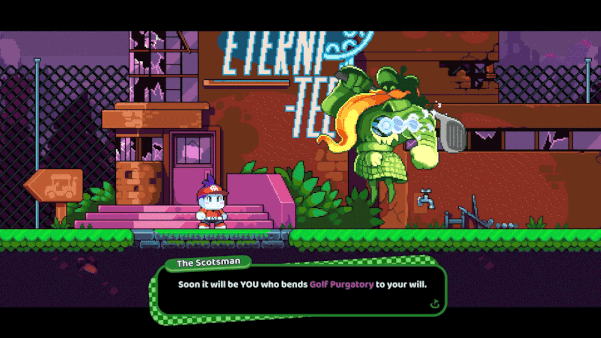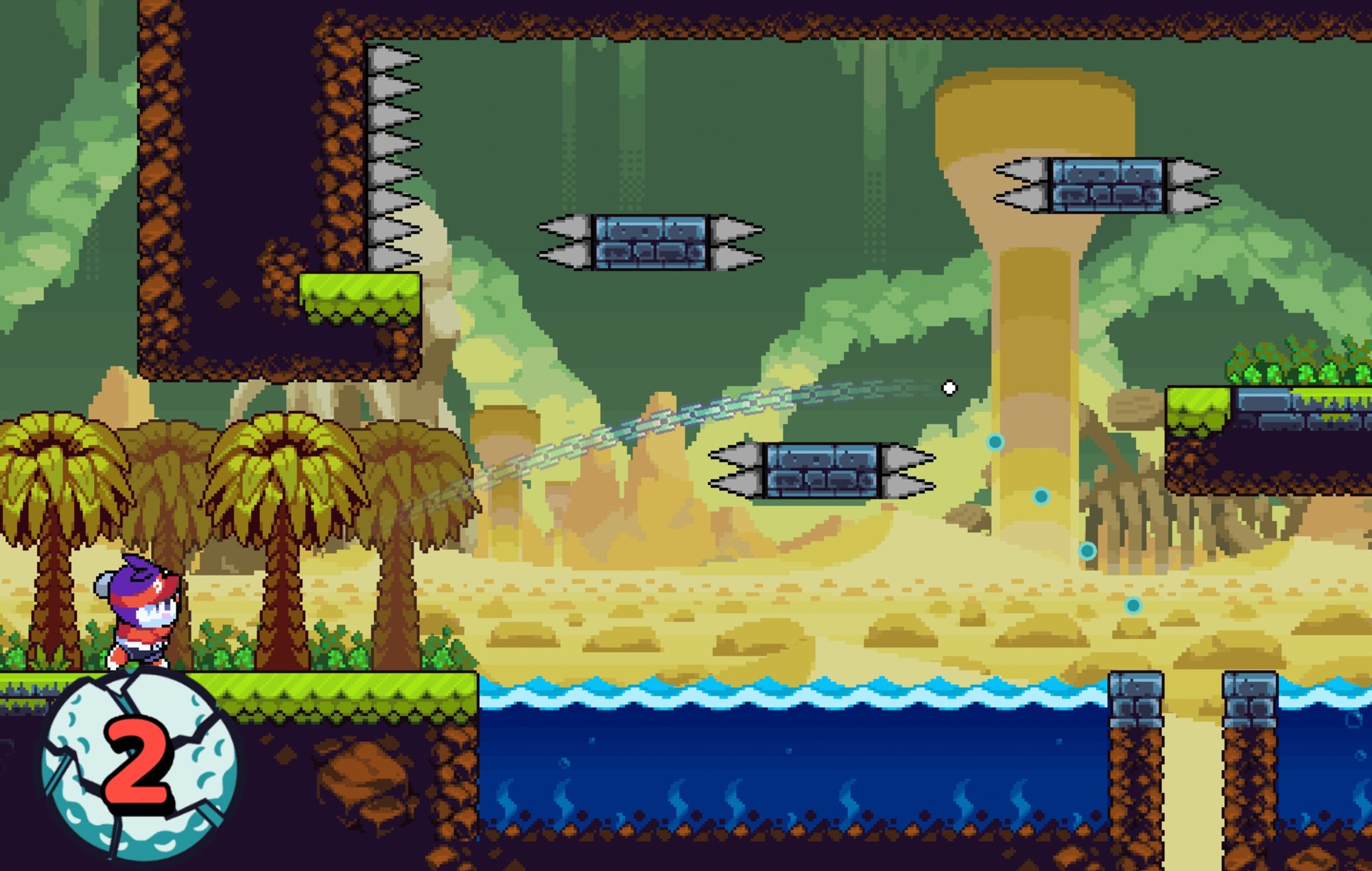Review | Cursed To Golf - Fire And Argyle
Back in the 90s and early noughties golf used to be a staple of the casual gaming scene, Nintendo and Sony had their flagship franchises that provided colourful alternatives to the yearly PGA releases. 20 years on from the swinging success of Toadstool Tour and the Everybody’s Golf franchise and things aren’t looking so good. The unceremonious shuddering of Sony’s Japan Studios forced Claphanz to partner with Apple while Mario’s latest golfing adventure has been relegated to being a full priced game that feels like an early access yet to get enough updates. And if you want to feel really old, EA killed off the PGA series seven years ago - with 2K's PGA series just never hitting the mark.
Golf games have been on life support for a good while now, and while there have been some indie gems here and there - Golf Club: Wasteland is a rather unique dystopian tale, while What The Golf manages to be a genuinely hilarious comedy game that just happens to use golf as a framing - but what we need is some much-needed new ideas to reinvigorate arcade golfing. Cursed to Golf doesn’t try to bring the golfing classics back from the dead; instead, it breathes new life into the genre with the addition of addictive roguelike elements, smart, accessible design and an adorable non-binary ghost trying their darndest to escape The Four Coursemen (and women) of The Apocalypse.
For their first swing at game development, Chuhai Labs game has managed to catch many people's attention thanks to vibrant environments and impressively expressive character designs that showed well in trailers and it certainly doesn’t disappoint in it's full release. 2D pixel art games are a dime a dozen but Cursed to Golf manages to stand out through its sheer attention to detail. I couldn’t recall a single moment where there wasn’t countless charming sprites or a plethora of elaborate animations on screen. In any given stage you will witness a gorgeous backdrop that helps to suck you into each of the four hellish landscapes, each one lovingly layered with golf-themed imagery and jokes including a golf ball-shaped moon and club shrubbery. Each obstacle, shortcut and feature has a dedicated animation; oversized fans produce sonic boom-like wind tufts, flags wave graciously in the wind and there are even teleporters that produce a funky light show. It is an underworld teeming with life and energy.
It all sounds rather excessive for a golf game, but it’s not just for show, each lavish animation helps players of all skill levels understand how the majority of features and mechanics work in an immediately recognisable manner, it also directs a player’s attention to the most important elements of every stage.
Even the underworld has bottomless pits.
Cursed to Golf is full of ambitious ideas that double up as subtle design elements that completely change the way the player golfs in the video game space. The most obvious think you wouldn't find on most gold links come in the form of roguelike elements including randomised courses, perishable power-ups and a ‘just one more try’ gameplay loop. In isolation, these seem like slight additions of modern popular mechanics to the classic golf gameplay we know and love, but when the new elements begin to play off of your expectations of golf the experience of playing through hell is anything but traditional.
As someone that has struggled when playing through the intimidating and ever-expanding scope of Binding of Isaac or the blisteringly fast-paced and content-heavy Hades, Cursed to Golf feels like it hits this sweet middle ground between action-heavy roguelikes and more methodical turn-based titles like Slay the Spire and Into The Breach. If you’re not familiar with these titles, that's more than okay as Cursed to Golf feels like the perfect entryway into the roguelike genre. There are classic staples like retrying runs from the very start upon death and random elements such as course layouts and power-ups but I’ve never seen another roguelike permanently kill off its bosses after they have been defeated. This mechanic alone, along with the powers you receive from bosses help massively with the game's pacing of a game where runs can last around 4 or 5 hours. That sounds pretty daunting, but it goes by pretty quickly with a constant sense of progression and huge, engaging levels that constantly keep your brain active.
Unlike the vast majority of procedurally generated roguelite's level designs, the greens in Cursed to Golf have all been handcrafted. This means that instead of changing every individual element of a course for a run, full courses are rotated in and out to create the feeling of a randomised game, while also allowing the developers to never have the game load up a run and trap the player in unbeatable courses. On paper, this seems like a fantastic idea to add structure to the golf-based roguelike, but with only around a hundred or so courses set across 18 holes, you’ll have seen all of the layouts after just 5 runs, just not all the combinations. Unfortunately, this familiarity of the courses makes the game too easy at times as it takes away the challenge involved with finding the best routes. This unfortunate design flaw is leveraged a little as the game goes on, with the final holes basically requiring the player to save their power-ups and know the best routes for completing some of the most brutal courses the golfing world has ever seen.
Thread the needle, again and again.
One of the main selling points of Cursed to Golf is the card-based power-ups which are mostly obtained through random card packs or chosen on their own at eterni-tee shops. They serve three main purposes that change the way that golf is played, some change the par counter to allow for more shots, others change the properties of the course, but the most interesting are the changes that can be made to the ball itself. These modifiers allow the ball to travel distances incapable of either a human or ghostly force, transformations such as the drill ball has the ability to take entire floors off the designated distance by cutting directly down through the core of the course, whereas the rocket ball allows players to utilise the skies and freely corner through tight gaps. However, when a shot is taken, the ability has to be manually activated while the ball is flying about, it's a little tricky to get the hang of at first as the timing required to pull these shots off is absurdly tricky for a cute golf game. But with a little practice and the addictive replayability of a golf based roguelike, timing these abilities will quickly become second nature.
Instead of trying to provide a golf simulation with an overwhelming amount of clubs, shot types and terrains, Cursed to Golf doubles down on simple and engaging moment-to-moment gameplay and fun ideas. Your initial impression of this ambitious golf game may leave you somewhat underwhelmed by a distinct lack of options, but, like any good roguelike, each of the game’s mechanics become easier to use as time goes on, even as the game expands on its complexity. The tiny selection of three clubs makes each shot type readable and easy to change on the fly. Segmented, obvious obstacles help with shot planning, which is especially useful in the multifaceted level designs that will quickly trip up players that get complacent all make Cursed to Golf better the more time you give it. There's also an infinitely replayable layup system that may seem too forgiving for players that like to live on the edge, but it almost completely eliminates any chance of accidental shots ruining your game 16 holes in.
Two most common golfing obstacles: Sand-traps and spike.
Cursed to Golf is easily one of the most accessible golf games around, expanding on ideas from modern, user-friendly titles like the Super Stickman Golf series, allowing anyone to pick up and play a potentially daunting premise. The risky yet rewarding gameplay that powers the greatest of golfing games has only been enhanced with randomised roguelike mechanics, hazardous level design and many other surprises that reveal the care and attention that has gone into pacing a satisfying journey through the layers of golfing hell. While there is some unusual activity seen in the strange camera angles projected at the start of courses and a UI that can block the shot information at certain heights (at least when playing on a Steam Deck). Missing out on what could potentially be the next reincarnation of the golf genre would be the real horror.










